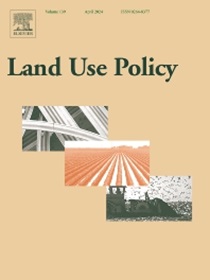Spatial rationalization of location value and use conversion cost in multiobjective land use optimization: Coupling hedonics pricing model and genetic algorithm
IF 5.9
1区 社会学
Q1 ENVIRONMENTAL STUDIES
引用次数: 0
Abstract
This study critiques global-based land use optimization methods and introduces a spatially rationalized framework to address their limitations. Global optimization often oversimplifies land value changes and use conversion costs by relying on averaged data, leading to unrealistic projections and inefficiencies. By contrast, the proposed spatial rationalization optimization framework integrates NSGA-II with a Ricardian-hedonic valuation model, providing a more accurate representation of local dynamics. Results of a case study, Mek’ele City in Ethiopia, illustrates that the global optimization outputs false signals on location value and use conversion cost whose policy implications are serious. The global optimization version false signals the land use conversion cost is 390.9 per square meter while the spatial rationalization version indicates the net change is a gain of 11.8. The spatial rationalization also maintains more areas with their original use indicating lower fiscal effect of implementing the optimal plan. The spatial allocation of uses aligns more closely with real-world conditions and enhances the effectiveness of land valuation strategies, such as land value capture. The findings highlight the need for spatially informed optimization in land use planning, advocating for policies that reflect true value changes and improve implementation accuracy. The study’s insights emphasize the importance of moving beyond global optimization frameworks.
多目标土地利用优化中区位价值与使用转换成本的空间合理化:享乐定价模型与遗传算法的耦合
本研究对基于全球的土地利用优化方法进行了批判,并引入了一个空间合理化框架来解决其局限性。全局优化往往依赖于平均数据,过度简化了土地价值变化和使用转换成本,导致不切实际的预测和低效率。相比之下,提出的空间合理化优化框架将NSGA-II与李嘉图-享乐评价模型相结合,能够更准确地表征局部动态。埃塞俄比亚Mek’ele市的案例研究结果表明,全局优化在区位价值和使用转换成本上产生了错误信号,其政策影响严重。全局优化模型表明土地利用转换成本为每平方米390.9美元,而空间优化模型表明净变化增加11.8美元。空间合理化也使更多的区域保持了原来的用途,这表明实施最优规划的财政效果较低。土地用途的空间分配更贴近实际情况,并提高土地估价策略(如土地价值获取)的有效性。研究结果强调了在土地利用规划中进行空间知情优化的必要性,倡导制定反映真实价值变化的政策,提高实施的准确性。该研究的见解强调了超越全局优化框架的重要性。
本文章由计算机程序翻译,如有差异,请以英文原文为准。
求助全文
约1分钟内获得全文
求助全文
来源期刊

Land Use Policy
ENVIRONMENTAL STUDIES-
CiteScore
13.70
自引率
8.50%
发文量
553
期刊介绍:
Land Use Policy is an international and interdisciplinary journal concerned with the social, economic, political, legal, physical and planning aspects of urban and rural land use.
Land Use Policy examines issues in geography, agriculture, forestry, irrigation, environmental conservation, housing, urban development and transport in both developed and developing countries through major refereed articles and shorter viewpoint pieces.
 求助内容:
求助内容: 应助结果提醒方式:
应助结果提醒方式:


